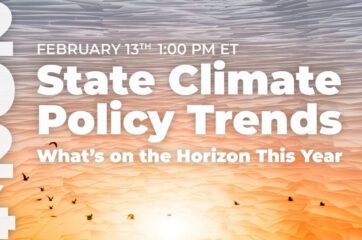Science-based, thoughtful policy design is a key component for states to address the intensifying climate crisis, but it’s not the whole picture. In order for climate policy to have the greatest chance for success, states must focus on effectively communicating what’s at stake: the risk of inaction and the health, social, and economic benefits of each policy.
Communicating complex policy information across different stakeholder groups can be difficult, and not just because of ongoing, decades-long misinformation campaigns by the oil and gas industry. We have the science and policy knowledge and expertise needed to establish robust climate policy, and this must coincide with strategic climate communications.
We invited a panel of expert climate communicators to dive into the latest research on Americans’ views around climate change and policy, alongside best practices and lessons learned on communicating climate information across communities, policymakers, researchers, and more. For this webinar, we were joined by Joshua Low, Partnerships Director at the Yale Program on Climate Change Communication, and Karen Florini, Senior Advisor at Climate Central.
In this recap article, we’ll provide highlights from our expert panel’s presentations, including the importance of knowing and connecting to your audience, Americans’ current beliefs on climate change and policy, and how to use climate visualization tools to advance campaigns.
Joshua Low, Yale Program on Climate Change Communication
Joshua leads the Yale Program on Climate Change Communication’s strategy for engaging and supporting the climate and clean energy advocacy, media, and education communities. He leverages a strong curiosity, evidence-based insights, and 20 years of experience leading social change campaigns to help organizations solve strategic challenges, clarify their goals, and develop capacity for strategic climate communications and transformational organizing. Prior to YPCCC, he managed campaigns and led organizing efforts that advanced bipartisan support for climate action, elected climate champions, and passed legislation that expanded access to clean energy.
Building Public and Political Will for Climate Action
Climate change is a massive collective action problem, and in order to pass effective climate policy, we must build public and political will. Public will involves a social system, a shared recognition of a particular problem, and the resolve to address that situation through sustained collective action. Political will is the willingness (or unwillingness) of government officials to enact effective policies at the required scale and speed to solve a particular problem. Movements and campaigns help create the public will that’s necessary for the foundation of how advocates can engage with policymakers to build political will.
In order to do this, you must follow the first rule of communication: know your audience. Your audience will not — and may not need to — think about climate change the same way that you do. People get involved for different reasons, from conserving wildlife to creating good jobs to simply making money, and it’s important to meet them where they’re at.
American Beliefs and Attitudes on Climate Change
Twice a year, the Yale Program on Climate Change Communications (YPCCC) and the George Mason University Center for Climate Change Communication conduct a nationally representative survey called Climate Change in the American Mind (CCAM). The most recent edition was conducted in spring of 2024, with a variety of findings across American’s beliefs and attitudes on climate change.
American beliefs about climate change and global warming
Seventy percent of Americans think global warming is happening, compared to only 13 percent who don’t. Further, 59 percent think global warming is mostly caused by human activities, which is important because if you don’t think humans caused global warming, then you may not think humans can do anything about it. Sixty-four percent are worried about global warming, including 28 percent who are very worried — around three times more than what it was in 2011, showing that progress has been made in helping Americans understand the issue. Lastly, while two thirds think global warming is affecting weather in the U.S., only one third regularly discusses global warming with family and friends.
American support for climate policies
Most registered voters support many climate-friendly policies such as soil sequestration funding, workforce training for fossil fuel industry workers, tax rebates for energy efficient vehicles or solar panels, regulating carbon dioxide as a pollutant, and more. While Democrats support these policies at higher percentages than Republicans, moderate Republicans are generally on board — for example, 55 percent of moderate Republicans support moving to 100 percent clean energy. This shows a real opportunity for bipartisan coalition building on climate issues.
A majority of registered voters support building climate-friendly energy production and distribution infrastructure like solar and wind farms, high-voltage power lines, and electric vehicle charging stations in their local area. This is important especially as the Inflation Reduction Act (IRA) continues to be implemented, spurring local issues between residents and clean energy developers. However, most registered voters have not heard much about the IRA — highlighting a big opportunity to educate Americans about major progress on the policies they already support.
Climate justice policies have strong bipartisan support, with a majority of registered voters supporting climate justice policies like creating more green spaces in low-income communities and communities of color, as well as strengthening enforcement of industrial pollution, improving energy efficiency in residential buildings, and increasing federal funding in such communities.
Local Climate Opinions
YPCCC also downscales this data to provide estimates at the local level. The Yale Climate Opinion Maps visualize their national survey data at the county, Congressional District, and state levels. The Yale Climate Opinion Factsheets take the data from the Climate Opinion Maps, allow you to select the survey questions you care about, and generate a factsheet of opinions in your local area.
Global Warming’s “Six Americas”
Americans don’t think about climate change along the binary of climate activists or deniers — they generally fall into one of six categories: Alarmed, Concerned, Cautious, Disengaged, Doubtful, and Dismissive. The majority of Americans (57 percent) are Alarmed or Concerned about climate change, with the difference being that the Alarmed (28 percent) think climate change is happening now, while the Concerned (29 percent) think it’s a more distant problem. The Alarmed outnumber the Dismissive (11 percent) by more than double, and that ratio is the same for almost every state and county or any size.
Over the last decade, people are moving from the Concerned to the Alarmed, with only 12 percent of Americans falling into the Alarmed category in 2012. In terms of demographics, certain groups are more likely to be Alarmed or Concerned:
- Young people are more likely than older generations, with 59 percent of Gen Z and Millennials in those categories compared to 53 percent each of Gen X and Baby Boomers.
- Women are more likely than men, with 59 percent of women in those categories compared to 52 percent of men.
- Hispanic/Latino and Black adults are more likely than White adults, with 64 and 61 percent in those categories, respectively, compared to 51 percent of White adults.
From Research to Action
Americans are clearly becoming more certain and more worried about the risks associated with climate change, but support for climate policy is only increasing slowly. While the country is becoming much more certain of the scientific consensus on climate change and associated harm to the U.S., they are not drastically increasing their level of support for regulating carbon pollution or for local officials doing more on climate — which may be partially due to already high levels of support. In terms of the Six Americas, many respondents who took the CCAM survey more than once are moving from the Cautious to the Concerned, and from the Concerned to Alarmed. We’re moving in the right direction, but there is more work to be done.
Impactful communication requires three key elements: the message, the messenger, and the reach. Even with the best message and messenger, you can’t make an impact without actually amplifying your reach, interacting with people, and delivering that message. Trusted messengers are very impactful — look to New Climate Voices highlighting conservative messengers or the Wild Center highlighting diverse, engaged residents in the local Adirondack area. Simple messages repeated often prove impactful as well, following the Five Facts, Ten Words model:
(1) Scientists agree → (2) It’s real → (3) It’s us → (4) It’s bad → (5) There’s hope.
Potential Energy has found that messages referencing protecting the planet for future generations, protecting ourselves from extreme weather, and protecting our health by reducing air and water pollution, are much more effective than messaging around reducing social inequality or increasing jobs, opportunities, and economic growth — more effective by 12 times, 7 times, and 5 times respectively.
We also need to break the cycle of silence and talk about climate change with our friends and family — and for those who may not feel we need to act now, educational messaging proves more effective than crisis messaging. We have to help them understand that most people agree and support climate solutions, as people who perceive a greater social consensus are more pro-climate and more engaged than those who perceive less consensus.
Karen Florini, Climate Central
Karen Florini is Senior Advisor at Climate Central, a climate science research and communication nonprofit, where she engages with key strategic partners including NGOs, educators, governments, and businesses. Prior to joining Climate Central in 2017, Karen served as Deputy Special Envoy for Climate Change at the State Department during the Obama Administration. Previously she worked at the Environmental Defense Fund both on environmental health and on climate change. She earned a law degree at Harvard, but now regards herself as a recovering lawyer.
Again: Know Your Audience
As Joshua described above, knowing your audience is extremely important — the first step in communicating effectively is understanding where people are, not where you would like them to be. Recent research from Potential Energy, summarized in Talk like a Human, explores how different messages work across various audiences. Topline recommendations include:
- Make it local
- Tie climate change to its consequences
- Talk about clean energy rather than eliminating certain industries
- Avoid “wonkspeak,” or technical jargon (for example, most people don’t relate to the term “net-zero”)
- Avoid partisanship
The report also outlines specific observations related to communicating with hard-to-reach audiences, including conservative Americans. The term “climate change” alone does not trigger backlash, but how you discuss it matters. The authors include a few recommendations related to avoiding backlash when speaking on this issue:
- Avoid the idea of bans; instead, emphasize increasing the accessibility and affordability of new technologies
- Avoid mentioning government action alone, which leads to concerns of governmental overreach; instead, always pair a discussion of government action with the real benefits to individuals, families, and communities
- Avoid crisis framing, which demands action now or else; instead, keep it local and emphasize the current, local consequences stemming from climate change, as relevant to your audience
- Avoid judgmental or guilt-based messaging; instead, uplift that climate action is not political
Tools to Visualize Local Climate Impacts and Solutions
Climate Central is a science research and communications nongovernmental organization (NGO) that aims to support media, governments, NGOs, and educators in communicating with their audiences. They have a wide array of free climate tools for anyone to use:
- Climate Matters – a weekly bulletin of production-ready static and dynamic graphics and analyses on climate impacts and solutions, in both Spanish and English, for use on air and social media for climate communicators. These discuss climate trends to date and future projections; associated consequences, such as impacts on allergy season, mosquito days, cooling demand, and even temperatures for football season; and the benefits associated with climate solutions. Bulletins are searchable by keyword and location at the Resources tab.
- WeatherPower – a tool that compiles information on all installed capacity of wind and solar in the U.S. and combines the data with current and forecasted weather data, to communicate the amount of electricity generated in any state, county, media market, or congressional district.
- Climate Shift Index – a map that quantifies the influence of climate change on local daily temperature across the world, showing how likely these temperatures are as a result of climate change. Coming soon is a Climate Shift Index map that will include sea-surface temperatures worldwide.
- Realtime Climate – a tool that continuously tracks weather in the U.S. and sends personalized, geographically specific alerts when something notable happens, with visuals pulled from the above three tools.
- Sea Level Rise tools
- Coastal Risk Screening Tool – an interactive mapping tool that visualizes local sea level rise and coastal flooding risks across the world by decade from 2030 to 2150.
- Risk Finder – an interactive website that includes maps, local sea level and coastal flood risk projections, and potential impacts for population (including demographic subgroups), buildings, infrastructure, land, and more.
- FloodVision – an initiative that is gathering on-the-ground data to generate photorealistic flood imagery of schools, streets, power plants, hospitals, and more.
Sign up to receive bulletins, alerts and/or newsletter updates at climatecentral.org/list-signup.
Q&A
Q: I continue to receive pushback from conservation-minded and other tangential groups who say they won’t share a message about using more renewable electricity or transitioning to heat pumps, because they don’t share political messages. Beyond saying it’s not political, do you have thoughts on how to convince these groups to share climate action messages?
Joshua Low: I think that climate change is political, and I think it’s okay that it’s political. That’s sort of the nature of how we’re going to win, is by engaging people in being active citizens to build public and political will, so that we can convince policymakers, business leaders, and others to do this. Part of the way that I would be thinking about getting more conservation minded people — I think there are ways to depolarize messages rather than depoliticize messages, meaning being nonpartisan, and I also like building relationships. I’m also using “political” in the broadest sense of the word; it’s about being an active citizen, not necessarily the Democratic Party-only sense. When I think about politics, politics is about power. And if we don’t think about power in this, we’re going to lose.
Karen Florini: I don’t disagree entirely with what you’re saying. On the other hand, I think if we try to do a frontal assault, and essentially say that you have to abandon your political identity with one party or another in order to take climate seriously — at the very least, that’s going to take a lot longer than the time that we have, given where we are with carbon levels in the atmosphere, and the fact that we actually have not yet managed to peak our emissions as a planet. So I think, again, to me, it comes back to audience. Depending on what audience you are talking to, then I think it actually is useful to not politicize it and instead, on that particular question that was just asked, to say, why is it political to say that you can have less carbon pollution if you use a heat pump? If somebody is bound and determined to refuse to message on one thing, I think it’s going to be very, very difficult to get past that. On the other hand, if they say that they agree with the climate science, and they see the impacts on, for example, wildlife, then what are they going to do if not help reduce emissions? I wish there was an easy answer. If there was an easy answer, we’d all be doing it! I do like the comment that’s in the chat: “You don’t have to abandon party ideology to support good policies.” I think that’s very nicely put.
Q: In New York, we’re having a real struggle with siting renewables and storage. The generalized concern about climate doesn’t seem to translate to the local level when a project is proposed. Have you worked to help turn things around on the ground when there’s backlash against renewables and siting?
KF: There is a wonderful document that’s been put together by the Sabin Center at Columbia Law School, that responds very specifically and in detail with very accurate and powerful counters to some of those things. If somebody is saying that they just don’t want any kind of construction in their area, that’s going to be very hard to get past. For some people, I think it is possible to say: look, this is important because of the central role that clean energy plays in addressing the climate context.
JL: I approach this more as an organizer. I think there have been some organizations that have done some really amazing work, doing deep canvassing and really having conversations with community members, meeting them where they’re at, listening to their concerns, and helping them work through that. There’s been some good work in Ohio and Michigan on that, there’s been some really good work from digital communicators, trying to have some of those same conversations over digital channels. And then there is some portion of the clean energy industry that needs to be investing in public affairs, making sure that these projects are good deals for the entire community, that they are meeting with a variety of stakeholders, not just a few decision makers, and making sure that they’re doing good community relations. There’s a group called Tigercomm that has been thinking a lot about that. And then Rural Climate Partnerships has also been doing some really great work on that.
KF: I completely agree with Josh, I think one of the most effective things that can be done to deal with some of the siting issues is a process that’s about the development of Community Benefit Agreements, where there’s a contractual agreement to do these things that will benefit the community where the renewable energy is being located. That may be a particularly powerful way to proceed.
JL: I would also have your ear to the ground. There’s been some places where this work has been funded by other, more nefarious folks. So, make sure that you have your ear to the ground for dis- and misinformation campaigns. And make sure to inoculate your community ahead of time, so that they are more interested in these projects.
Conclusion
Communicating effectively on climate is a complex issue, one that is different for each campaign and for each audience, but there are some best practices across the board. Knowing your audience and meeting them where they’re at is essential, as is avoiding shame-based or crisis messaging. It’s also important to refer to the latest climate communications research — we have decades of experience and knowledge held by climate communicators, and building on these lessons learned will help us catalyze change from the local level up. There are also a plethora of free climate visualization tools to aid in connecting with your audience on the issues that they care most about. If we pair the latest climate science and policy with effective messaging tactics, we can make the change we need on the short timeline we have — and build community while we’re at it.
* The views and opinions expressed by our guest speakers during the webinar and summarized in this article are their own and do not necessarily reflect the views or positions of Climate XChange.








